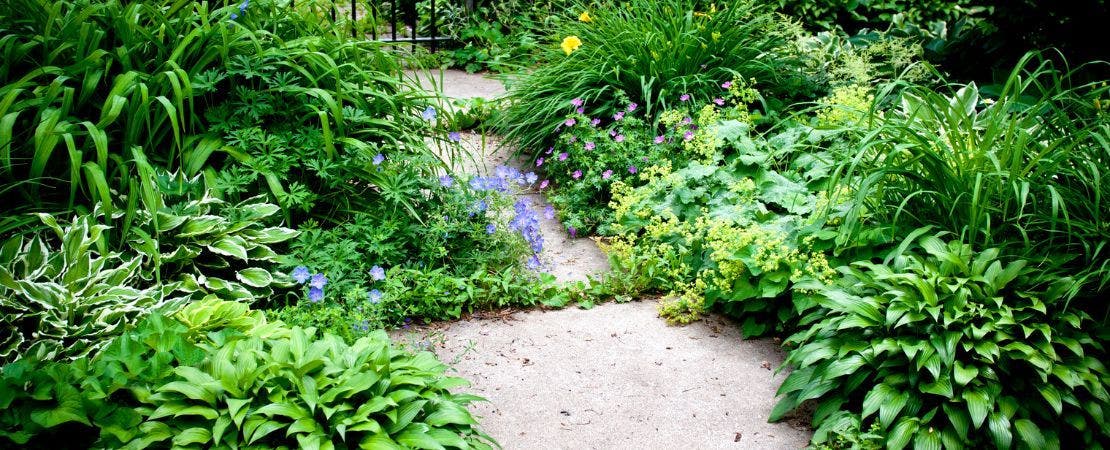Many gardens have shady areas. These spots get little sunlight. Growing grass or flowers there can be hard. But ground cover plants do well in shade. They make your garden look nice. They also help stop weeds and hold soil.

Credit: www.housedigest.com
What is Ground Cover?
Ground cover is a type of plant. It grows low and spreads wide. It covers the soil like a green carpet. These plants can grow fast and fill empty spots.
Ground cover is good for many reasons:
- Stops weeds: It covers the soil, so weeds cannot grow easily.
- Protects soil: It keeps soil from washing away when it rains.
- Keeps moisture: It helps soil stay wet for longer time.
- Looks good: It adds green color and texture to your garden.
Why Plant Ground Cover in Shade?
Shade means less sunlight. Many plants need full sun to grow well. But shade plants are different. They like little or no direct sun.
Shady areas can be under trees, near buildings, or in places blocked by other plants. These spots may be dry or moist. Ground cover plants made for shade can grow in these places.
Using ground cover in shade helps:
- Fill empty, dark spaces with green plants.
- Keep soil cool and moist.
- Reduce dirt and mud in rainy weather.
- Make your garden look fresh all year.
Choosing the Right Ground Cover for Shade
Not all ground cover plants like shade. Some need sun. You must pick plants that grow well in low light.
Here are some good ground cover plants for shade:
| Plant Name | Light Needs | Growth | Special Features |
|---|---|---|---|
| Hosta | Full to partial shade | Medium spread | Big leaves, many colors |
| Pachysandra | Full shade | Slow spread | Evergreen, good for dry shade |
| Liriope (Lilyturf) | Partial to full shade | Clumping growth | Grass-like leaves, purple flowers |
| Sweet Woodruff | Full to partial shade | Fast spread | Small white flowers, fragrant |
| Ajuga (Bugleweed) | Partial shade | Fast spread | Colorful leaves and blue flowers |
How to Prepare the Area for Planting Ground Cover
Before planting, you must get the area ready. Here is how:
- Clear weeds and grass. Remove all plants you do not want.
- Loosen the soil. Use a garden fork or spade to break the soil.
- Add compost. Mix in organic matter to help plants grow.
- Level the ground. Make sure the area is flat and smooth.
Good soil helps ground cover plants grow strong.
Steps to Plant Ground Cover in Shade
Planting ground cover is easy. Follow these steps:
- Choose healthy plants or seeds. Buy from a garden store or nursery.
- Space plants properly. Check the label for how far apart to plant.
- Dig holes for each plant. Make holes wide and deep enough.
- Place plants in holes. Put roots in soil and cover gently.
- Water well. Water each plant after planting.
- Add mulch. Mulch keeps soil moist and stops weeds.
Check your plants every week. Water when soil feels dry.

Credit: www.epicgardening.com
Care Tips for Ground Cover in Shade
Ground cover plants need care to stay healthy.
Here are simple care tips:
- Water regularly, especially in dry times.
- Remove weeds that grow between ground cover plants.
- Trim or prune plants if they grow too much.
- Fertilize once or twice a year with plant food.
- Watch for pests. Insects or bugs can harm plants.
Common Problems with Ground Cover in Shade
Sometimes, ground cover plants face issues. Knowing these helps you fix problems fast.
| Problem | Cause | Solution |
|---|---|---|
| Yellow or brown leaves | Too much water or poor soil drainage | Water less and improve soil drainage |
| Plants not spreading | Too much shade or poor soil | Thin tree branches or add compost |
| Weeds growing | Not enough mulch or weak ground cover | Add mulch and pull out weeds |
| Insect damage | Pests like slugs or beetles | Use natural pest control or remove pests by hand |
Benefits of Ground Cover for Your Garden
Ground cover plants add many benefits. Here are the main ones:
- Stops soil erosion. Helps keep soil in place during rain.
- Improves soil health. Adds organic matter and keeps soil moist.
- Reduces weeds. Covers soil so weeds cannot grow easily.
- Looks attractive. Adds color and texture to shady areas.
- Low maintenance. Needs less care than grass or flowers.
Final Thoughts
Planting ground cover in shade is a smart idea. It helps your garden look green and neat. It protects soil and stops weeds. Choose the right plants for your shade level. Prepare the soil well before planting. Water and care for the plants regularly.
With patience and care, your shady spots will become beautiful green spaces. Ground cover makes your garden happier and healthier. Give it a try this season.
Frequently Asked Questions
What Are The Best Ground Cover Plants For Shade?
Hostas, ferns, and vinca are ideal for shady areas. They thrive without much sunlight.
How Do I Prepare The Soil For Ground Cover?
Remove weeds. Loosen the soil. Add compost for nutrients. Ensure good drainage.
How Often Should I Water Shade-tolerant Ground Cover?
Water weekly. Keep the soil moist but not waterlogged. Adjust based on rainfall.
Can Ground Cover Prevent Weeds?
Yes, it can. Dense growth blocks sunlight, which stops weeds from growing.
5 min read

